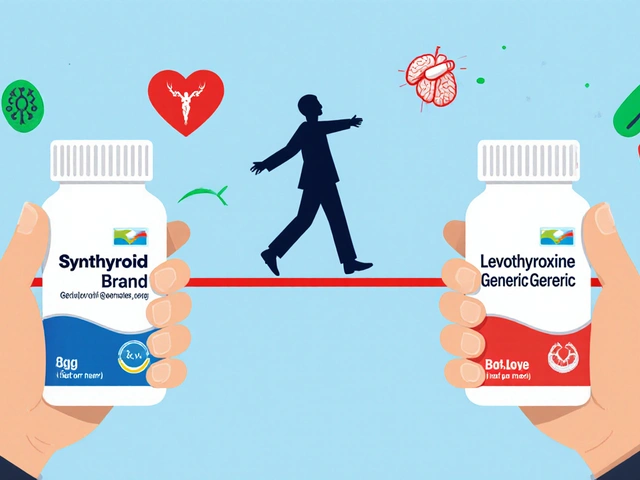The hardest part about getting seizure meds online isn’t clicking Buy. It’s staying safe, staying legal, and making sure the pills in your bottle match what keeps you stable. If you need to buy Dilantin online, you need two things: a valid prescription and a pharmacy you can trust. This guide walks you through both. No shortcuts, no sketchy sites, no wonky advice-just a clean path to getting your meds on time without risking your health.
What you’ll get here: a simple plan to pick a licensed online pharmacy, a price rundown that makes sense in 2025, red flags to avoid, and backup moves if a shipment is late. Quick note: this is practical guidance, not medical advice. Keep your prescriber in the loop.
What to know before you buy
Dilantin is the brand name for phenytoin, an antiseizure medicine used to control certain types of seizures. It comes as extended-release capsules (often 100 mg), chewable tablets (50 mg), and an oral suspension (common strength: 125 mg per 5 mL). The generic is labeled phenytoin or phenytoin sodium, depending on the form and country. In many cases, the generic works well and costs a lot less.
You need a valid prescription to buy Dilantin online in most regions, including the United States, Canada, the UK, and the EU. Any site that claims you don’t need a prescription for phenytoin is a red flag. The FDA’s BeSafeRx program, the National Association of Boards of Pharmacy (NABP) Accredited Digital Pharmacy program, the UK’s MHRA registration, and EU national regulators all set the standard for legal online pharmacies. Stick to those signals.
Before you order, get clear on your product specifics. This part matters because phenytoin has a narrow therapeutic window. That means small differences in dose or how the drug releases can change your blood level. Extended-release capsules are not the same as immediate-release chewables or suspension. Don’t switch forms, brands, or even manufacturers without looping in your prescriber. Many neurologists prefer keeping patients on the same product to avoid level swings. Epilepsy Foundation guidance and neurology practice statements have repeated this point for years: if you must switch, watch for side effects and consider checking blood levels soon after.
Know your dose timing and refill rhythm. A lot of folks on maintenance meds do best with a 90‑day supply. That cuts shipping delays and pharmacy fees. If you tend to run tight near the end of the month, ask your doctor to write refills early or authorize a 90‑day script through a mail‑order pharmacy. Mail‑order usually pairs well with stable, long‑term meds like phenytoin.
Interactions matter. Phenytoin plays badly with a bunch of drugs, including certain antibiotics, antifungals, and other seizure meds. Alcohol can also throw off levels. If you’re starting or stopping anything new, check with your pharmacist or prescriber. Women who may become pregnant should discuss risks and folate with their clinician; guidance from regulators like the FDA, EMA, and professional bodies emphasizes careful planning here.
Last thing before you buy: consistency is your friend. Keep the same manufacturer when you can. If your pharmacy needs to switch manufacturers, ask them to tell you before they ship. If they do switch, make a note of the new pill’s imprint and color, and ask about checking a blood level if you notice changes in seizure control or side effects.
Where to safely buy online in 2025 (and what it should cost)
Your safest options are licensed, accredited pharmacies that will verify your prescription and clearly show who owns and operates the site. Here’s a simple decision path to pick the right channel.
- If you have insurance and a stable dose: use your plan’s preferred mail‑order pharmacy. These are often run by large, well‑known companies and tie directly into your benefits. Copays are predictable, 90‑day fills are common, and shipping is usually included.
- If you’re paying cash or want to compare prices: check a large national chain’s online service or a licensed digital pharmacy accredited by the NABP or your national regulator. Many offer visible cash prices and discount options.
- If you need a new prescription or dose change: talk to your neurologist or primary prescriber. Telehealth can help with refills in some cases, but seizure care is not one‑size‑fits‑all, and starting phenytoin should be supervised.
How to confirm a pharmacy is legit:
- Look for accreditation. In the U.S., NABP’s Accredited Digital Pharmacy seal and .pharmacy domains are solid signals. In the UK, look for MHRA registration and the UK logo for online sellers. In the EU, check the national regulator logo used across member states. Canada has provincial college licensing and the CPhA Pharmacy Verified Program. If a site has no clear licensing info, walk away.
- Demand a real prescription. A safe pharmacy will ask your doctor to send it, or will offer to contact your doctor to confirm. Sites that let you self‑fill a script for phenytoin are not acting legally.
- Check for a physical business page and pharmacist contact. Legit pharmacies list their corporate name, licensing states or countries, and a way to reach a pharmacist for questions.
Ballpark 2025 pricing in the U.S. (cash, without insurance; your numbers may vary by dose, quantity, and discount program):
- Phenytoin ER 100 mg capsules (generic), 90‑count: roughly 15 to 60 USD with common pharmacy discount programs.
- Dilantin ER 100 mg capsules (brand), 90‑count: commonly 400 to 800 USD cash. Prices swing by location and stock.
- Phenytoin oral suspension 125 mg per 5 mL, 120 mL: often 20 to 50 USD.
- Phenytoin chewable 50 mg, 100‑count: often 10 to 40 USD.
Insurance copays may be lower, especially for generics with 90‑day mail‑order. If you’re brand‑dependent, ask about prior authorization and any brand‑med exceptions your plan supports. Some plans require trying the generic first. If your prescriber marks Dispense as Written (DAW) for clinical reasons, your plan may cover brand at a higher tier.
Step‑by‑step to place a safe order:
- Find your current bottle and write down the exact product: brand or generic, form, strength, and the manufacturer on the label.
- Check your insurance portal for the preferred mail‑order pharmacy. If you pay cash, shortlist two or three accredited online pharmacies or major chains for a price check.
- Ask your prescriber for a 90‑day prescription with refills if appropriate, and note any DAW or “keep same manufacturer” instructions.
- Create your pharmacy account and add your prescription details. Select the exact NDC or manufacturer if the site allows. If not, message support and request the same manufacturer you’re currently on.
- Upload insurance info or choose cash‑pay. If cash‑pay, apply a pharmacy discount card or coupon offered by the site. Compare the final price across your shortlist before you commit.
- Set auto‑refill and refill reminders. Aim to reorder when you have 7 to 10 days left so shipping hiccups don’t become missed doses.
- When the package arrives, check the bottle: name, strength, form, manufacturer, and pill imprint. If anything is different, pause and call the pharmacy before taking it.
- Store at room temperature, away from heat and moisture. If you got a suspension, shake well before each dose and note the beyond‑use date once opened.
- Tell your prescriber about any changes in manufacturer, dose timing, or side effects. Ask whether to check a phenytoin level after a switch or dose change.
What to avoid:
- Any site offering phenytoin without a prescription.
- Unverifiable overseas sellers shipping into the U.S. or EU. Personal import rules are tight and risky. Customs holds happen, and quality can be unknown.
- Listings on general marketplaces where the seller is not a licensed pharmacy.

Risks, red flags, and smart mitigations
Counterfeit risk is real online. Reputable regulators have seized fake antiseizure meds from rogue sites in the past. Your best protection is accreditation, a valid prescription process, and packaging that matches what you expect. If the bottle looks off, the seal is broken, or the imprint doesn’t match known references, don’t take it-call the pharmacy and your prescriber.
Red flags worth acting on:
- No pharmacy license details on the website, or licenses that don’t match the states or countries they ship to.
- Prices that are unbelievably low, bundled with promises of no prescription needed.
- No pharmacist contact or refusal to answer basic questions about manufacturer, lot numbers, or storage conditions.
- Weird shipping routes or customs declarations that don’t match a pharmacy shipment.
Clinical risks you can actually control:
- Switching products: if a manufacturer change happens, watch for dizziness, balance issues, vision changes, or breakthrough seizures. If anything shifts, call your prescriber. They may order a blood level and tweak your dose.
- Formulation mix‑ups: extended‑release capsules are not chewables. Do not crush or split extended‑release capsules. If you can’t swallow capsules, ask about alternative forms with your clinician.
- Drug interactions: new meds can push levels up or down. Tell your pharmacy about every med and supplement you take. Ask for a check before you start or stop anything significant.
- Missed doses: if shipping is late, ask the pharmacy for a local bridge fill or call your prescriber for a short emergency supply. Planning for a 90‑day fill reduces the chance you run out.
Money risks and how to sidestep them:
- Sticker shock on brand: if you truly need brand Dilantin, talk to your clinician about documentation and plan exceptions. If brand isn’t required, generic phenytoin is usually much cheaper.
- Dispensing fees and shipping: some online pharmacies add fees that wipe out discounts. Compare the final checkout price, not just the unit price.
- Out‑of‑network pharmacies: if you use a non‑preferred pharmacy, your copay can jump. Check your plan’s preferred list first.
Quality checks you can do at home:
- Imprint match: compare the pill’s letters and numbers to images from your pharmacy information sheet or a reputable drug reference app.
- Label match: confirm brand or generic name, strength, and manufacturer all match the prescription.
- Lot and expiry: look for a clear expiration date. For suspension, note the beyond‑use date once opened; many suspensions have shorter on‑shelf times after opening.
Quick comparisons, FAQs, and next steps
Online mail‑order vs local pickup:
- Best for mail‑order: stable dose, predictable refills, cost savings on 90‑day supplies, less travel.
- Not ideal for mail‑order: frequent dose changes, urgent starts, or if you’ve had shipping delays in your area.
Brand Dilantin vs generic phenytoin:
- Best for brand: patients with a history of breakthrough seizures after switching or those whose prescriber has documented clinical need.
- Best for generic: most patients who tolerate phenytoin well and want lower costs. If you switch, keep the same manufacturer and watch for changes.
30‑day vs 90‑day supply:
- 30‑day: more flexibility if your dose might change soon.
- 90‑day: better pricing and fewer refill crunches for stable regimens.
Suspension vs capsules:
- Suspension: helpful if you can’t swallow pills, but it needs shaking and exact measuring. Levels can vary more. Storage and expiry matter.
- Capsules: steadier for many, and simpler for mail‑order logistics.
Mini‑FAQ
- Can I buy Dilantin without a prescription? No. In the U.S., UK, EU, Canada, and most other regions, phenytoin requires a prescription. Sites offering it without one are unsafe and often illegal.
- Is generic phenytoin as effective as Dilantin? For many people, yes. Regulators like the FDA and EMA approve generics that meet bioequivalence standards. Because phenytoin has a narrow therapeutic window, some patients notice differences when switching products. Work with your prescriber, keep the same manufacturer when possible, and consider level checks after a switch.
- Are international pharmacies legal to use? Laws vary. In the U.S., personal importation of prescription drugs is generally restricted. Parcels can be seized, and quality is uncertain. Safer route: use a licensed pharmacy in your country.
- How long does shipping take? Typical mail‑order delivery takes 3 to 7 business days once the pharmacy has the prescription. Weather and carrier issues can slow things. Reorder with at least 7 to 10 days of medicine left.
- What if my pharmacy suddenly changes the manufacturer? Call them to document the change and ask your prescriber whether to check a phenytoin level. Monitor how you feel and report any changes promptly.
- What if my order is delayed and I’m about to run out? Call the pharmacy first; ask for an emergency local pickup transfer or a partial fill. If that fails, contact your prescriber for a short bridge script.
- Can I return meds if the bottle looks wrong? Laws vary, but most pharmacies can’t accept returns of dispensed meds. They should replace orders that are wrong or damaged. Don’t take anything that looks tampered with.
Next steps you can act on today:
- Decide your channel: insurance mail‑order if covered, or an accredited online pharmacy if paying cash.
- Ask your prescriber for a 90‑day prescription with refills and a note to keep the same manufacturer when appropriate.
- Set up your account, upload the script, and turn on refill reminders. Choose discreet, trackable shipping.
- When the first order arrives, verify the label, manufacturer, and pill imprint. Save a photo for future reference.
- Schedule a check‑in with your prescriber if your product changes or if you notice side effects. Ask about a blood level draw after any switch.
Troubleshooting by scenario:
- Price too high on brand: ask your prescriber about clinical justification and plan exceptions; check manufacturer support programs; compare 90‑day mail‑order pricing.
- Pharmacy keeps switching manufacturers: request a note on your profile to keep the same supplier; if they can’t, consider a pharmacy that can source your preferred NDC.
- Frequent dose changes: switch to 30‑day fills at a local pharmacy until your dose is stable, then move back to mail‑order.
- Moved to a new state or country: confirm that your online pharmacy is licensed where you now live; transfer prescriptions as needed before you run out.
Credibility notes: Safety checks and legal requirements align with FDA BeSafeRx, NABP accreditation standards, and national regulators such as MHRA in the UK and EU member agencies. The caution on product switching reflects guidance and experience widely shared by neurologists and patient groups like the Epilepsy Foundation. For clinical decisions, always work with your own prescriber.







Just got my 90-day supply shipped from CVS mail-order and the pills looked different so I panicked but then I checked the NDC code and it matched my old bottle-thank god. Don’t let the color change freak you out, just verify the imprint and manufacturer. I’ve switched generics three times and still seizure-free.
Let me just say this: the fact that you’re even considering buying Dilantin from some sketchy overseas vendor without a prescription is a terrifying indictment of our healthcare system. Not because it’s illegal-it’s because you’re trusting your neurological stability to a website that probably uses a .xyz domain and a PayPal account registered to ‘DilantinKing420’. Phenytoin isn’t vitamin C. It’s not something you order when you’re bored on a Tuesday night. You’re not buying sneakers. You’re buying the difference between consciousness and convulsions. And if you don’t treat it with that gravity, you’re not just risking your health-you’re disrespecting every neurologist, pharmacist, and patient who’s spent decades fighting for regulatory integrity. And yes, I know you’re going to say ‘but it’s cheaper!’-well, so is cyanide, but nobody’s asking you to swallow that either.
THIS. So glad someone said it. 😭 I was terrified when my pharmacy switched manufacturers last month but I called my neurologist and we did a blood level-turned out I was fine! Just needed to chill. Also, use GoodRx-it saved me $300 on my 90-day supply. 💪
You speak of legality as if it were a moral absolute, yet you ignore the systemic failures that force people into these positions. In India, where I am from, many epileptic patients cannot afford brand Dilantin-yet the same pharmaceutical corporations that profit from patent monopolies in the U.S. produce generics in our country at a fraction of the cost. Why should an American patient suffer because their insurance refuses to cover a drug that is legally manufactured and FDA-approved elsewhere? The real villain is not the patient who seeks affordable medication-it is the profit-driven healthcare industrial complex that turns survival into a luxury. Your outrage is performative. Your compassion? Nonexistent.
It’s not about affordability. It’s about control. The pharmaceutical industry doesn’t want you to know that generics are bioequivalent. They want you dependent. They want you afraid. And they’ve spent billions convincing you that ‘brand’ equals safety. But if you look at the FDA’s own data, the differences in absorption between generics and brand are statistically negligible. So why do they charge 10x? Because they can. And you’re complicit if you pay it without fighting.
There’s a quiet grief in the way we navigate these meds-the fear of a missed dose, the anxiety of a changed manufacturer, the silent vigil of checking pill imprints like they’re sacred glyphs. We don’t talk about how it feels to be so dependent on a tiny capsule, how it becomes part of your identity: ‘I’m the one who takes phenytoin.’ It’s not just medicine-it’s the architecture of stability. And when that architecture shifts, even slightly, the whole house trembles. So yes, we check the labels. We call the pharmacy. We track the NDCs. We do all of this because we’ve learned, through trauma, that the world doesn’t always keep its promises. But the right pharmacy? They do. And that’s worth holding onto.
Just wanted to say thank you for this guide. I’ve been on phenytoin for 12 years and this is the first time I’ve read something that actually gets it. I used to get so mad when pharmacies switched my manufacturer without telling me. Now I just call and say ‘I need the same NDC as last time’ and they usually honor it. Also-yes, 90-day fills are life-changing. I used to have panic attacks at day 25. Now I just breathe. 🙏
Have you seen what happens when people order from ‘Canadian’ pharmacies? I work for customs. Last month we seized 147 packages labeled ‘Dilantin’ from ‘PharmaExpressCanada’-all of them were fake. Some had sugar. Some had chalk. One had traces of rat poison. And guess what? The people who ordered them were all American. You think you’re saving money? You’re gambling with your brain. And if you die because you trusted a website that says ‘24hr shipping’? Don’t blame the government. Blame your own stupidity.
Let’s be honest-this entire guide is just a corporate PR pamphlet disguised as patient advocacy. The Epilepsy Foundation? Tied to Big Pharma. The NABP? Funded by mail-order pharmacies. The ‘trusted’ pharmacies you recommend? They all have stock in the same parent companies. You’re not giving advice-you’re selling a product. The real solution? Decriminalize personal importation. Let people buy from India. Let them buy from Mexico. Let them buy from the actual manufacturers. Stop treating patients like children who can’t handle truth. The system is rigged. This guide just polishes the cage.
I’m from South Africa and we don’t have access to Dilantin here at all. My sister gets her meds shipped from a UK-licensed pharmacy. We’ve been doing it for 5 years. No issues. No seizures. No seizures. No seizures. The key? Only use pharmacies with a .pharmacy domain, verify the license number on the MHRA site, and always call the pharmacist before accepting delivery. It’s not magic. It’s just due diligence. And yes, it’s expensive-but so is a hospital stay.
I think what’s missing here is the emotional labor of being a chronic patient. It’s not just about the pill-it’s about the phone calls, the screenshots, the spreadsheets tracking expiration dates, the guilt when you forget to refill, the shame when you have to ask your doctor for a bridge script because you ran out. We’re not just managing a condition-we’re managing a system that wasn’t built for us. So when someone shares a tip like ‘use GoodRx’ or ‘ask for the same manufacturer’-it’s not just practical advice. It’s survival. And we’re all just trying to stay alive, one pill at a time.
Esteemed author, your exposition on the procurement of phenytoin is both methodical and commendable. The delineation of accreditation standards across jurisdictions demonstrates a profound grasp of regulatory frameworks. However, one might posit that the emphasis on institutional trust, while prudent, inadvertently reinforces structural inequities. For the economically disenfranchised, the ‘safe’ pathway you outline remains inaccessible. Perhaps the truest form of safety lies not in accreditation seals, but in universal access to affordable, standardized antiepileptic medication-a public health imperative transcending national borders. With profound respect, I submit this as a gentle counterpoint.
While your article contains a modicum of factual accuracy, it fundamentally fails to address the ethical bankruptcy of pharmaceutical monopolies. The fact that a 90-day supply of generic phenytoin can cost as little as $15 while the branded version exceeds $800 is not a market failure-it is a moral catastrophe. To advise patients to ‘use insurance’ or ‘apply for discounts’ is to endorse a system that commodifies neurological stability. The real solution is not better pharmacy selection-it is the dismantling of patent protections on life-saving medications. Until then, every ‘safe’ purchase is an act of complicity.